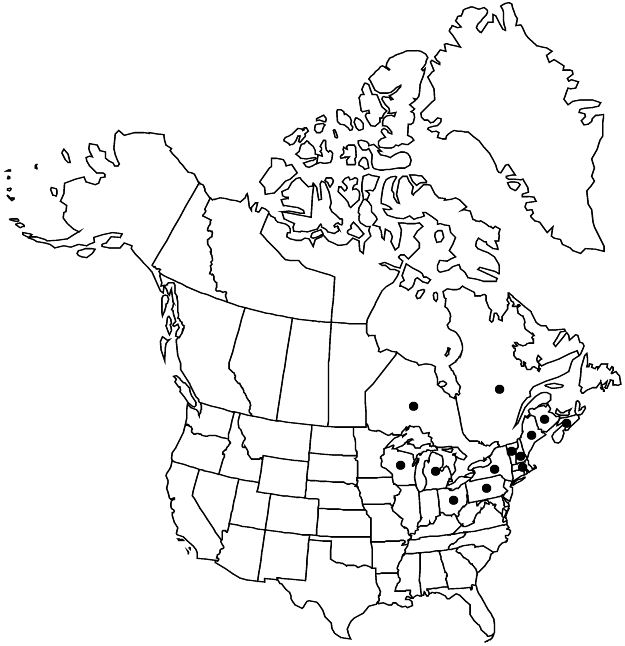Crataegus submollis
Bot. Gaz. 31: 7. 1901.
Shrubs, sometimes trees, 60–70 dm. Stems: twigs: new growth appressed-pubescent, 1-year old tan to brown, older gray; thorns on twigs usually numerous, straight to curved, 2-years old shiny blackish, ± thick, 4–7 cm. Leaves: petiole length 30–50% blade, densely pubescent, ± glandular, glands black; blade ± broadly ovate to rhombic-elliptic, 4–9(–11) cm, chartaceous, base cuneate to almost truncate, lobes 3–5 per side, obscure on smaller leaves, sinuses shallow to moderately deep, lobe apex acuminate, margins sharply, doubly serrate, on larger leaves teeth 2–3 mm, gland-tipped at least initially, veins 5–7 per side, apex acute to subobtuse, abaxial surface sparsely appressed-pubescent, sometimes glabrescent, veins abaxially pubescent, adaxial densely scabrous-pubescent young, variably glabrescent. Inflorescences 5–15-flowered; branches densely pubescent; bracteoles caducous, linear, membranous, margins sessile-glandular, larger similar but late-deciduous, more herbaceous. Flowers 20–22 mm diam.; hypanthium tomentose; sepals narrowly triangular, 6–7 mm, margins deeply glandular-serrate, abaxially pubescent; stamens 10(or 20), anthers ivory; styles (3–)5. Pomes bright red, suborbicular to pyriform or ellipsoid, 10–15 mm diam., hairy, especially proximally and distally; sepals prominent, erect-patent, stiff; pyrenes 3–5. 2n = 68.
Phenology: Flowering May–Jun; fruiting Sep–Oct.
Habitat: Brush, natural hedgerows, field margins, apparently calciphile
Elevation: 20–400 m
Distribution

N.B., N.S., Ont., Que., Maine, Mass., Mich., N.H., N.Y., Ohio, Pa., Vt., Wis., introduced in Europe.
Discussion
Crataegus submollis ranges from eastern Wisconsin and northern Michigan through the limestone areas of southern Ontario into Quebec, and New York to Maine and southern Nova Scotia. It is occasionally found in Pennsylvania and is plausible for northern West Virginia. It is allopatric with C. mollis. Crataegus submollis has also been recorded wild in Europe, including France and northern Italy.
Crataegus submollis, though quite similar to C. mollis, differs in its distribution, stature, petiole glandularity, stamen number, and greater thorniness.
The typical form of Crataegus submollis has proportionately broader leaves that are broadly cuneate to subcordate basally. By contrast, C. champlainensis is a form with proportionately narrower leaves more or less truncate to subcordate at the base. Intermediate forms are common in Quebec and New England. Placing the 20-stamen C. canadensis, a distinctive local form from the Montreal area, with C. submollis is based on leaf shape, glandular petioles, and disjunction from the range of C. mollis. Crataegus arnoldiana is a form with particularly large fruit.
Possession of glandular petioles and similar flowering time means that Crataegus submollis can sometimes show surprising similarity to large specimens of C. chrysocarpa. Then, the large fruiting calyces and the tendency to a more herbaceous larger bracteole type of C. submollis, typical for ser. Molles, differentiate.
Selected References
None.